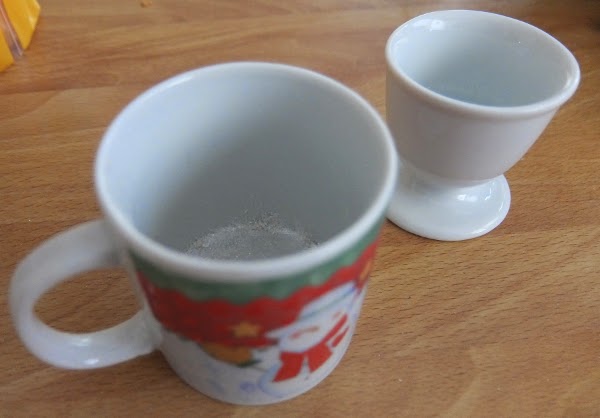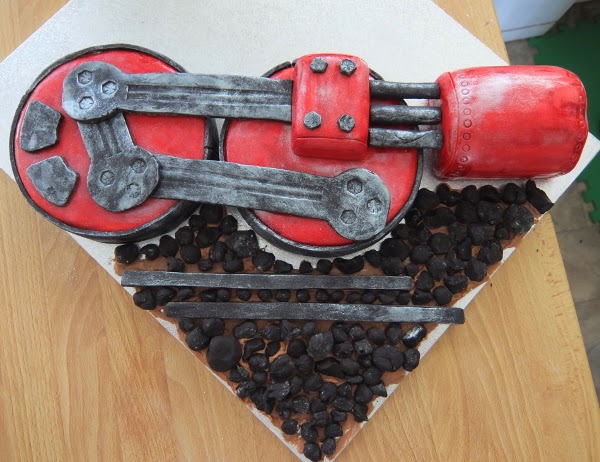I was going to write more about our NZ trip, and I will next week, but today is recipe day, so I’m going to run through how I made C’s 7th Birthday cake. Seven? How did that happen? And after convincing him that I couldn’t design a cake with the cake-wheels on edge with an axle in between that would move, I worked through some sketches of train wheels till I had executive approval for this design.
It’s two train wheels, with a piston sitting on a train track in a coal yard. And as far as cakes go, this one wasn’t the hardest I have ever made. Working with fondant is like working with playdoh. Though it does taste rather commercial – next time I will be experimenting with different flavours but I ran out of time this year. I also think the cakes would be improved with the additions of a jam layer – something tart, like apricot, so I will be experimenting with that too at a later date.
Anyway, enjoy the chaos!
    |
| Cake pans |
Banana Cake:
Ingredients
4 bananas, mashed
1 cup rice flour
1/2 cup GF cornflour
1/2 cup GF Bread mix
125g nutalex or GF/DF margarine
splash of olive oil
1/3 cup brown sugar
2 eggs
1/2 tsp vanilla
1/2 cup rice milk
1 tsp bicarb soda (check!)
1 circle cake tin ( 15-18cm width)
1 rectangle tin
Method
Add the nutalex, oil and sugar and beat until combined. Add the eggs and beat again. Then mix in the vanilla. Mash the bananas well till smooth. Add to the batter and stir. Add the bicarb soda to the milk. Alternatively add the flours and milk, mixing after each addition.
Grease the cake tins with oil, and line with baking paper. I used a spring-form pan for the circle tin. Fill about 1/2 way, to leave room for rising. Bake in a medium oven (in our oven this is a hot, fan-forced 160 deg Celcius), for about 1/2 hour. When they are browned on top and springy to the touch, they are done. If they brown too soon, turn off the fan-forced and turn the heat down a bit and leave for another 5-10 mins. Leave to cool on a tray or plate.
I made a double batch of this recipe to make 2 circle cakes and 1 square cake.
Lemon Raspberry Buttercream:
    |
| Cake Design |
Ingredients
A handful of frozen raspberries
A few tsp of lemon juice
1 container of GF icing sugar
125g nutalex or GF/DF margarine
Method
Sift the icing sugar. (I used our strainer and push the icing through.) It also is quick to do in a food processor.
Add the nutalex and mix in until all the nutalex is broken up and combined. Defrost and slightly cook raspberries in the microwave (watch them, they can catch on fire!) for 10-30 secs.
Strain out the raspberry juice. (I do this by pushing the cooked raspberries through a tea strainer – it works great!) Add the juice to the icing mix and stir. Now add enough lemon juice so that the icing stirs easily – do this a bit at a time and thoroughly mix in each time. Too much lemon juice and it will go runny! And as my mum says, adding icing sugar to liquid just gets tackier liquid…
    |
| Train parts templates |
Fondant Icing:
Ingredients
1 small bucket (1 kg) Black Satin GF icing
1 small bucket (1 kg) Red Satin GF icing
Icing sugar (for dusting)
Ruler
Knife
Kids tools
Decorative items (for indenting)
Method
This is much easier to work with than I expected, but not exactly a taste sensation.
Prepare a work surface – I used the kid’s craft / dinner table. Clean thoroughly and dry, then dust with icing sugar. Pull out only as much fondant as needed for each item being created / iced.
Knead for a short amount of time until it is soft and playdoh-like in texture. Give a bit to the kids to play with – and some kid tools.
Roll out the fondant till flat, and make sure you shift it a little after each roll so that it doesn’t stick. Roll to about 3-4 mm thick.
Now you can do the cutting etc. Follow this process for each piece.
Creating the Decorations
    |
| Brushes and Pearlescent Sugar |
Ingredients
Black fondant
Icing sugar
Pearlescent dry sugar (edible sparkly sugar)
Paint brushes
A few small containers
Tongs or some other long thin implement with raised impressions along it’s length
A clean bolt
Ruler
Knife
Method
Using the black fondant, roll out a piece, and lay out the stencils of the gears and cut-outs. Used a knife to gently cut them out. Do not use long knife cuts, as the fondant will stick and pull!
    |
| Tongs for fondant impression |
Remove from the rest of the fondant and clean the edges. Then gently press the bolt into the bulbous end. I did three impressions. Along the tang, line up the tongs, and gently press into the fondant. Do the same with all three gear stencils.
To make the bolt shapes, place the bolt bolt-side down on the fondant, and carefully cut around the edges. This will take a bit of trial and error, and will need a bit of trimming and reshaping with a knife or flat edge till they become bolt-head shaped.
    |
| Bolt |
To make the pistons, estimate the distance between the piston pump and the square-gear – it’ll be 5-8cm, depending on your cake board and where you place the cakes.
Cut straws to this length, or possibly a little longer. Cut a strip of fondant the same width as the straws. Place the straw on the fondant, and gently roll until the straw is covered. Cut along the edge and then carefully join the two ends together – you can damp one edge if you want to make it stick. Don’t smooth out the seam-line too much – a rough look is actually an advantage.
For the train-tracks, roll out a long sausage shape, and then use a flat object, like a ruler to flatten it into a square shape.
    |
| Train decorations |
For the rocks – let the kids go wild rolling marble-shapes. The rougher look is better than a smooth one.
Save some black fondant for the wheels around the circle cakes – you can’t make these early.
To decorate, you will need 2 small containers – one has a small amount of pearlescent sugar dust, the other with a little water; and a paint brush. As you will be eating the result, please use a new paint-brush that hasn’t been used on non-edible paint…
    |
| Dry-brush detail |
To dry brush, damp the brush, then mostly dry it. Then add a small amount of paint dust to the brush. Tap the brush on the edge of the container. When you paint, start at the edges and add slowly. If you’ve done model-painting before, like I have, food-dust paint works a little differently, and tends to go on very heavily, and then not-at-all once it gets sticky on the brush. Aim for the more textured points – like the bolt impressions, or ridges.
    |
| Coal rocks |
Use this technique on the gears, bolts and train-tracks. Leave the rocks so they have a coal-look.
I prepared these a few days in advance. But it was so humid, that they had trouble setting! I put the in the oven with just the fan on for half a day, which helped. Then I put them in a sealed container overnight in the fridge. But I cheated – I stole the desiccator packets from vitamin bottles and placed them in with the fondant – it absorbed a lot of the excess liquid and worked brilliantly.
Cake Assembly
Ingredients
Cakes ( 2 15-18cm round cakes, and 1 10x15cm rectangle cake)
Buttercream
    |
| Small containers |
1 kg red fondant
Left-over black fondant
Pre-prepared decorations
Parisian browning essence
Pearlescent sugar dust
Paint Brushes and 3 containers
A piece of cardboard
A super-large cake board (Over 1.5 ft t least!)
Method
This design needs two 15-18cm cakes (the smaller diameter, the better), and one small 15 x 10 cm rectangle cake. They might be hard to find, so it’s worth spending a bit of time looking for the right size. It’s best not to use a normal-size round tin – that’s too huge! This design will take a double batch of banana cake batter.
Once the cakes are baked, leave them to cool completely. Then it’s time to cut them to shape. The two circle cakes will need to be the same height with a flat top – I cut mine to 3cm thick with a large knife. As they are small, it probably doesn’t need to be cut using a string-cutting method to get a flat top. But as you will be flipping the cake upside down to ice, you don’t need it to be perfect. Save the off-cuts!




Now you have all the pieces you need to assemble the cake.
Ice the cakes with a small amount of buttercream icing. Ice the circle cakes cut-side down. I went a bit thin, but a normal icing thickness will be too thick. Ice the pieces separately. With the arched rectangle cake, ice the base cake, then add the additions, then ice the top of the additions. Shape the cake with the icing to the desired shape.
I put the cakes in the fridge afterwards. As it was a cold day, this was probably a mistake which caused problems later with the fondant. If the cakes need to be cooled fast, pull them out of the fridge at least 1-2 hours before you cover with fondant so they can get back to room temperature.
Take out a large chunk of the icing – about 1/3 of the tub. Follow the fondant preparation instructions to roll flat. Measure the width and height of the circle cake. Roll out the fondant until it is circle width + 2 x height in size all the way around.




Do the same for the large rectangle cake – don’t forget to measure both directions. It’s also worth rolling the fondant out to at least 1-2 cm wider than necessary.
To transfer the fondant onto the cake, roll onto the dusted rolling pin, then carefully place over the cake. To shape it, gently push it in, from the bottom up – don’t pull the fondant! To smooth it, use a small ball of extra fondant and rub it gently over the surface. Cut the fondant roughly around the edges of the cake to remove bulk, then shape it in and carefully cut around the edges. You want it to be flush with the surface.
Do the same for all the cakes – do the square ones last, as they are going to be the ones without edging, and practice helps. Square cakes are a little harder – you might need to work the edges and trim a little closer to get a good finish. Make sure to smooth out all bubbles on the fondant. The small cake should be able to be iced with the left-over fondant from the other three cakes.
To add patterns – use a knife to cut straight lines along the edges of the square cakes on 2 sides (only about one millimetre deep!). Then to make ‘rivet’ shapes, indent along one edge of the line with the end of a straw.
If, like mine did, the fondant starts to sweat because it’s on a too-cold cake, this is easy to fix. Gently dust with icing sugar and work in with a paint-brush. Keep adding icing sugar until it stops being sticky.
To assemble the cake, place the large rectangle cake first – on a diagonal. Then place the two circle cakes on the same diagonal line. You will then be able to figure out the placement of the small rectangle on the middle circle cake. Also check the distance between the two square cakes with the piston-fondant pieces, to make sure they will fit snuggly.




Add a decent amount of Parisian browning essence to the buttercream till it goes a nice brown. Fix the position of the cakes with a blob of buttercream under each cake. Put the buttercream on the bottom of the small cake before attaching it to the middle circle cake.
Roll out a long thin piece of black fondant. Measure the height of the fondant-covered circle cakes and cut the black fondant into long strips of the same width. The lengths will need to be slightly over 3 times the cake-width when added together. I did 2 strips on one circle, and 3 on another. Smooth and work the edges so that they join when attached to the cake. The underside might need to be dampened slightly with a paint brush so it slicks to the cake edge. Don’t smooth the short edges flat – it’s meant to be slightly rough looking!
Put a little browning essence in a small container and dilute with some water. Then carefully paint with a brush all over the red fondant. Make sure that the brown colour gets into all the lines and circles. It can also be used it to damp down the colour of any white icing spots. It does not need to be an even coating – different levels of colour add to the mottled effect, but don’t use too much!
The cakes will then need to be completely dry before doing the pearlescent paint. It’s going to take a while for it to dry, even with a fan blowing over it to help – a few hours at least.
Once the fondant is dry, dry brush as before – dry brushing the edges of the black fondant strips, and a light dusting over the red fondant. If it goes on heavy in places, that’s OK as well, as it’s meant to be a slightly-used metallic look and the mottled levels of colour help with the effect.
It’s now time to assemble the decorations! Work out where the gears will be placed – the thin edges will go under the fat edges. Where the gears go between the cakes, help prop it up with a strategically-placed piece of cardboard (~ 3cm wide, slightly less than the width of the gears). Damp the bottom slightly to stick the pieces to the cake.
Work three of the pistons into position between the two square cakes. Damp the edges to help them stick. If the straws were cut to be a little too long, stick them into the red-cake fondant to help attach them firmly. (I didn’t need to do that, but it might be necessary in hotter weather.)
Place the bolts on the small square cake, again damping them underneath so they stick.
At the lower edge of the cake board, smear it with the brown buttercream. Place the two train tracks, and then get the kids to help place the coal – lots of fun!
And that’s it. Now you have a train wheel-piston cake! Wasn’t that fun?






